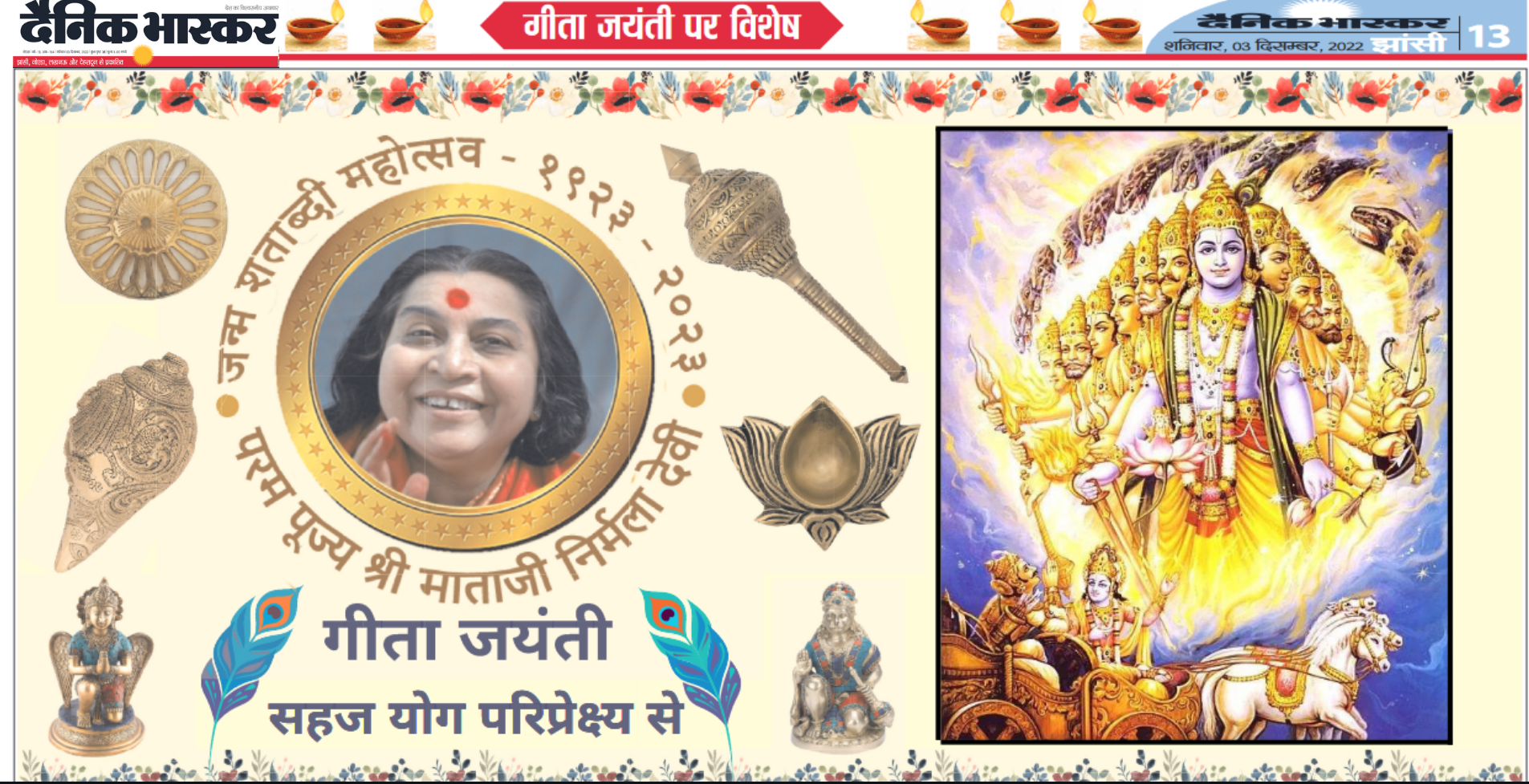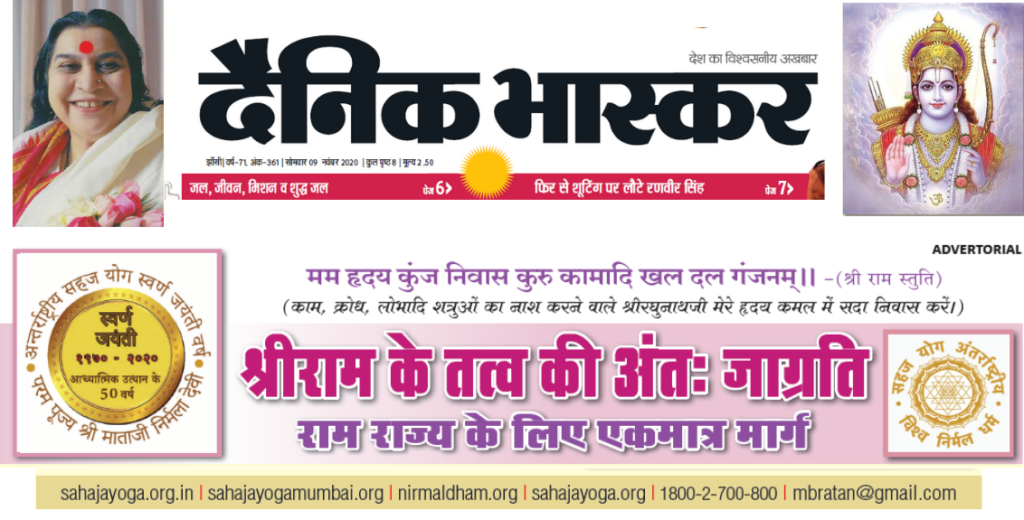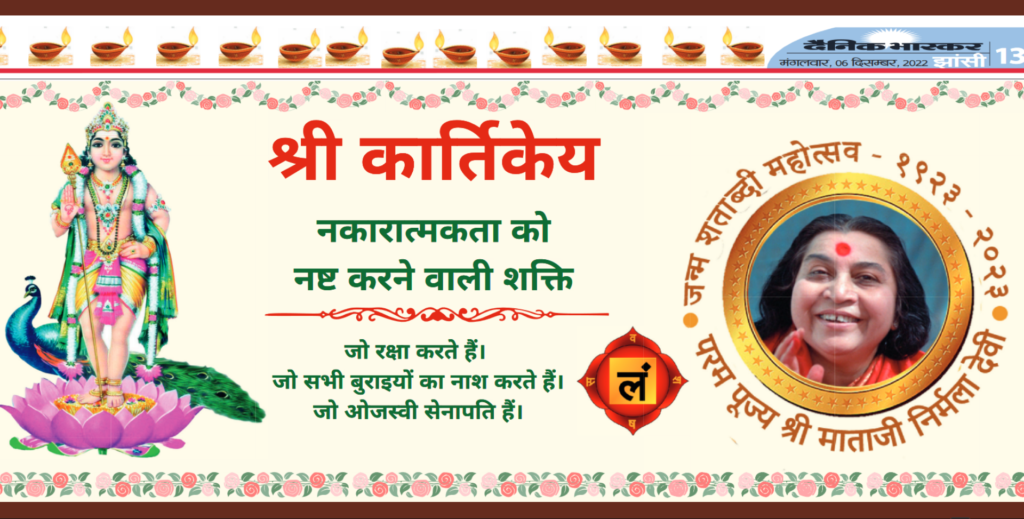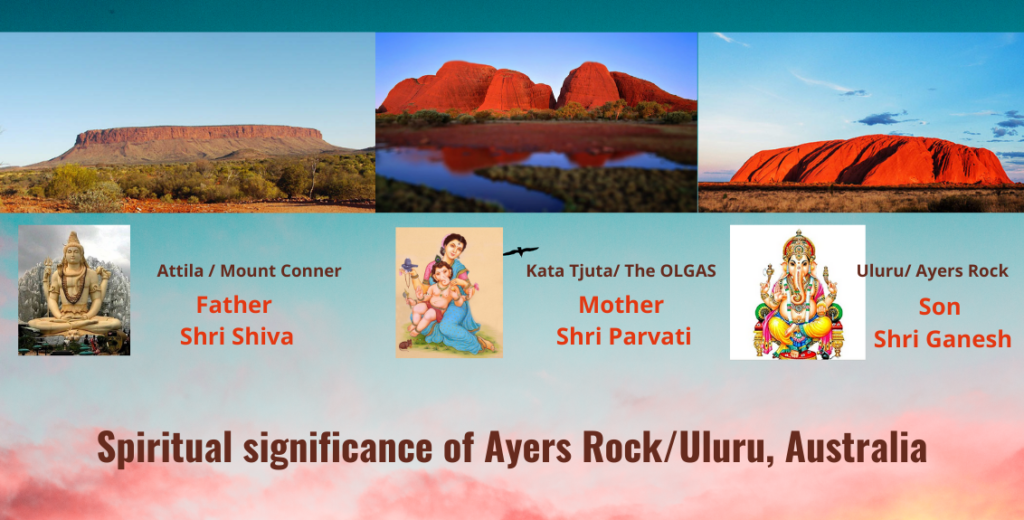On the auspicious occasion of Gita Jayanti – 3rd December 2022, an article was release in Dainik Bhaskar by Sahaja Yogis to commemorate the birth of the Holy Bhagvad Gita in the Dwapar Yuga! Details given below – along with English translation of the same.
gita-jayanti-hindi03-DECEMBER
DB-Jhansi-03-DEC-2022
bhaskar-pdf-03-december-2022
https://epaper.dainikbhaskarup.com/view/1260/03-dec-2022
गीता जयंती – सहज योग परिप्रेक्ष्य से
गीता जयंती का दिन हिंदुओं के पवित्र ग्रंथ श्रीमद भगवद-गीता के जन्म का प्रतीक है। मार्गशीर्ष मॉस में शुक्ल पक्ष के 11 वें दिन यह जयंती मनाई जाती है।
भगवद गीता या “भगवान का गीत” हिंदू धर्म के सबसे महत्वपूर्ण धार्मिक ग्रंथों में से एक है और साधारणतः सर्वाधिक प्रसिद्ध है। यह शताब्दियों से लेखकों, कवियों, वैज्ञानिकों, धर्मशास्त्रियों, और दार्शनिकों – दूसरों के बीच – द्वारा उद्धृत किया गया है और अक्सर पश्चिमी दर्शकों के लिए हिंदू धर्म का परिचयात्मक पाठ है। हमारे समय के कई महान विचारकों जैसे कि अल्बर्ट आइंस्टीन, महात्मा गांधी, और अल्बर्ट श्वेइज़र के साथ-साथ माधवाचार्य, शंकर और रामानुज जैसे बीते युगों ने इसके कालातीत संदेश पर चिंतन और विचार-विमर्श किया है।
पवित्र भगवद गीता, पांच पांडव राजकुमारों में से एक अर्जुन और श्री विष्णु के 8वें अवतार श्री कृष्ण के बीच एक संवाद का वर्णन करती है। इस महाकाव्य में श्री कृष्ण, अर्जुन के सारथी की भूमिका में होते हैं । अर्जुन और उनके भाइयों को 13 साल के लिए राज्य से निर्वासित कर दिया गया था और परिवार के एक अन्य गुट द्वारा उनकी सही विरासत से पृथक कर दिया गया था; गीता सिंहासन को पुनः प्राप्त करने के लिए उनके संघर्ष को उठा लेती है, जिसके लिए आवश्यक है कि अर्जुन को अपने सारे सैन्य कौशल को सहन करते हुए स्वयं के परिजनों के विरुद्ध युद्ध छेड़ना चाहिए।
कहानी कुरुक्षेत्र के धूल भरे मैदानों से शुरू होती है, जहां अर्जुन, एक प्रसिद्ध तीरंदाज, लड़ने के लिए तैयार है। परन्तु परन्तु संकोच करता है। वह अपने मित्रों, शिक्षकों, और रिश्तेदारों के खिलाफ कतारबद्ध देखता है, और मानता है कि लड़ने के लिए – और संभावित रूप से मारने के लिए – इन लोगों के प्रति गंभीर पाप करना होगा जो कुछ भी अच्छा नहीं ला सकता है भले ही वह राज्य को वापस जीत लेने की बात हो । कृष्ण, उसे उसकी कायरता के लिए डांटते हैं – अर्जुन योद्धा जाति से है, और योद्धा लड़ने के लिए होते हैं – परन्तु फिर अपने शत्रुओं से लड़ने के लिए एक आध्यात्मिक तर्क पेश करते हैं, जिसमें कर्म, ज्ञान और भक्ति की चर्चा शामिल है। योग, साथ ही देवत्व की प्रकृति, मानव जाति की अंतिम नियति, और नश्वर जीवन का उद्देश्य देते हैं ।
गीता उच्चतम गूढ़ सिद्धांतों से युक्त ग्रंथ है। इसकी भाषा इतनी मधुर है कि कोई इसे आसानी से समझ सकता है परन्तु संदेश इतना गहरा है कि कोई अपने जीवनकाल में इसे पूरी तरह से पूरा नहीं कर सकता है। श्रीकृष्ण द्वारा कही गई गीता इतनी गूढ़ है कि ऐसा कोई शब्द नहीं है जो आध्यात्मिक पहलू से रहित हो।
18 अध्याय, 700 श्लोक
भगवद गीता के अठारह अध्यायों को तीन खंडों में विभाजित किया जा सकता है। पहले 6 अध्याय कर्म योग या कर्तव्य पथ का वर्णन करते हैं। दूसरा सेट, अध्याय 7 से 12 तक, ‘भक्ति’ के मार्ग, या भगवान के प्रति प्रेमपूर्ण भक्ति की महिमा करता है। वे भक्ति का पोषण करने वाले दिव्य अमृत के रूप में भगवान के ऐश्वर्य का भी वर्णन करते हैं। तीसरा सेट, अध्याय 13 से 18 तक, तत्त्व ज्ञान, या ज्ञान शास्त्र के नियमों और सिद्धांतों पर व्याख्या करता है।
पवित्र गीता से कुछ चुने श्लोक
कर्म योग या कर्म द्वारा योग
इन्द्रियाणि पराण्याहुरिन्द्रियेभ्यः परं मनः।
मनसस्तु परा बुद्धिर्यो बुद्धेः परतस्तु सः ॥ (Ch. 3, ver. 42)
स्थूल शरीर से इन्द्रियाँ श्रेष्ठ हैं और इन्द्रियों से श्रेष्ठ मन है। मन से परे बुद्धि है और बुद्धि से भी परे आत्मा है।
एवं बुद्धः परं बुद्ध्वा संस्तभ्यात्मानमात्मना ।
जहि शत्रु महाबाहो कामरूपं दुरासदम् ॥ (Ch.3, ver. 43)
इस प्रकार बुद्धि से भी उच्च आत्मा को जानकर और बुद्धि से मन को वश में करके इस दुर्गम शत्रु रूपी कामना का संहार करो।
सच्चे आध्यात्मिक गुरु का महत्व
तद्विद्धि प्रणिपातेन परिप्रश्नेन सेवया।
उपदेक्ष्यन्ति ते ज्ञानं ज्ञानिनस्तत्त्वदर्शिनः ॥ (Ch. 4, ver. 34)
आध्यात्मिक गुरु के पास जाकर सत्य को जानें। श्रद्धा से उससे पूछो और उसकी सेवा करो। ऐसे प्रबुद्ध संत आपको ज्ञान प्रदान कर सकते हैं क्योंकि उन्होंने सत्य को देखा है।
यज्ज्ञात्वा न पुनर्मोहमेवं यास्यसि पाण्डव ।
येन भूतान्यशेषेण द्रक्ष्यस्यात्मन्यथो मयि ॥ (Ch. 4, ver. 35)
इस मार्ग पर चलते हुए और एक गुरु से ज्ञान प्राप्त करने के बाद, हे अर्जुन, तुम अब भ्रम में नहीं पड़ोगे। उस ज्ञान के प्रकाश में, तुम देखोगे कि सभी जीव परमात्मा के अंश मात्र हैं, और मेरे भीतर हैं।
अपि चेदसि पापेभ्यः सर्वेभ्यः पापकृत्तमः ।
सर्वं ज्ञानप्लवेनैव वृजिनं सन्तरिष्यसि ॥ (Ch. 4, ver. 36)
यहां तक कि जो सभी पापियों में सबसे अनैतिक माने जाते हैं, वे भी दिव्य ज्ञान की नाव में बैठकर भौतिक अस्तित्व के इस महासागर को पार कर सकते हैं।
सार्वभौमिक प्रेम और करुणा
तबुद्धयस्तदात्मानस्तन्निष्ठास्तत्परायणाः ।
गच्छन्त्यपुनरावृत्तिं ज्ञाननिषूतकल्मषाः ॥ (Ch. 5, ver. 17)
जिनकी बुद्धि ईश्वर में स्थिर है, जो ईश्वर में पूर्ण रूप से लीन हैं, उनमें परम लक्ष्य के रूप में दृढ़ विश्वास रखते हैं, ऐसे व्यक्ति ज्ञान के प्रकाश से अपने पापों को दूर करके शीघ्र ही उस स्थिति को प्राप्त कर लेते हैं, जहां से कोई वापसी नहीं होती है।
विद्याविनयसम्पन्ने ब्राह्मणे गवि हस्तिनि ।
शुनि चैव श्वपाके च पण्डिताः समदर्शिनः ॥ (Ch. 5, ver. 18)
दिव्य ज्ञान की आँखों से, वास्तव में विद्वान एक ब्राह्मण, एक गाय, एक हाथी, एक कुत्ते और एक कुत्ते को खाने वाले को समान दृष्टि से देखते हैं।
बाह्यस्पर्शेष्वसक्तात्मा विन्दत्यात्मनि यत्सुखम् ।
स ब्रह्मयोगयुक्तात्मा सुखमक्षयमश्नुते ॥ (Ch. 5, ver. 21)
जो बाह्य इन्द्रिय सुखों से आसक्त नहीं हैं वे स्वयं में दिव्य आनंद का अनुभव करते हैं। योग के माध्यम से भगवान के साथ एक होने के कारण वे अनंत सुख का अनुभव करते हैं।
योऽन्तःसुखोऽन्तरारामस्तथान्तर्योतिरेव यः।
स योगी ब्रह्मनिर्वाणं ब्रह्मभूतोऽधिगच्छति ॥ (Ch. 5, ver. 24)
जो अपने भीतर प्रसन्न हैं, भीतर भगवान के आनंद का आनंद ले रहे हैं, और आंतरिक प्रकाश से प्रकाशित हैं, ऐसे योगी भगवान के साथ जुड़ जाते हैं और भौतिक अस्तित्व से मुक्त हो जाते हैं।
लभन्ते ब्रह्मनिर्वाणमृषयः क्षीणकल्मषाः।
छिन्नद्वैधा यतात्मानः सर्वभूतहिते रताः ॥ (Ch. 5, ver. 25)
वे पवित्र व्यक्ति, जिनके पाप नष्ट हो गए हैं, जिनके संदेह नष्ट हो गए हैं, जिनके मन अनुशासित हैं, और जो सभी प्राणियों के कल्याण के लिए समर्पित हैं, वे भगवान को प्राप्त करते हैं और भौतिक अस्तित्व से मुक्त हो जाते हैं।
कर्म, पुनर्जन्म और आत्मा की अमरता
प्राप्य पुण्यकृतां लोकानुषित्वा शाश्वतीः समाः ।
शुचीनां श्रीमतां गेहे योगभ्रष्टोऽभिजायते ॥ (Ch. 6, ver. 41)
मृत्यु के बाद असफल योगी पुण्यात्माओं के लोकों में जाते हैं। कई युगों तक वहाँ रहने के बाद, वे फिर से पृथ्वी लोक में पवित्र और समृद्ध लोगों के परिवार में पुनर्जन्म लेते हैं।
अथवा योगिनामेव कुले भवति धीमताम् ।
एतद्धि दुर्लभतरं लोके जन्म यदीदृशम् ॥ (Ch. 6, ver. 42)
अन्यथा योग के दीर्घ अभ्यास के कारण यदि उनमें वैराग्य उत्पन्न हो गया होता, तो वे दिव्य ज्ञान युक्त कुल में जन्म लेते हैं। इस संसार में ऐसा जन्म प्राप्त करना बहुत कठिन है।
तत्र तं बुद्धिसंयोगं लभते पौर्वदेहिकम् ।
यतते च ततो भूयः संसिद्धौ कुरुनन्दन ॥ (Ch. 6, ver. 43)
ऐसा जन्म लेकर वे अपने पिछले जन्म के ज्ञान को पुनः प्राप्त करते हैं, और योग में सिद्धि के लिए और भी अधिक प्रयास करते हैं। ऐसे साधक स्वाभाविक रूप से शास्त्रों के कर्मकांड के सिद्धांतों से ऊपर उठ जाते हैं।
प्रयत्नाद्यतमानस्तु योगी संशुद्धकिल्बिषः ।
अनेकजन्मसंसिद्धस्ततो याति परां गतिम् ॥ (Ch. 6, ver. 45)
पिछले कई जन्मों के संचित पुण्यों के साथ, जब ये योगी आगे की प्रगति करने के लिए ईमानदारी से प्रयास करते हैं, तो वे भौतिक इच्छाओं से शुद्ध हो जाते हैं और इसी जीवन में पूर्णता प्राप्त करते हैं।
दिए गए श्लोकों का एक ही अर्थ है – सर्वव्यापक शक्ति से एकाकार हो जाना । यही योग है। शुद्ध आध्यात्मिक दृष्टि से योग का अर्थ है ‘आत्मा’ का ‘परमात्मा’ से मिलन। एक बार जब योग पूरा हो जाता है तो सभी प्रकार का कल्याण होता है।
जैसा कि श्री कृष्ण कहते हैं:
अनन्याश्चिन्तयन्तो मां ये जनाः पर्युपासते।
तेषां नित्याभियुक्तानां योगक्षेमं वहाम्यहम् ॥ (Ch. 9, ver. 22)
हालाँकि, जो भक्त किसी और से प्रेम नहीं करते हैं, वे लगातार मेरे बारे में सोचते हैं और एक निःस्वार्थ भावना से मेरी पूजा करते हैं, जो हमेशा मेरे साथ विचारों में एकजुट रहते हैं, मैं पूरी सुरक्षा लाता हूं और व्यक्तिगत रूप से उनकी जरूरतों को पूरा करता हूं।
अब बात यह है कि योग और यौगिक अवस्था को कैसे प्राप्त किया जाए। सहज योग की संस्थापिका परम पूज्य श्री माताजी निर्मला देवी क्या कहती हैं:
धर्म के सभी प्रकार के कर्मकांडों को दूर करने के लिए, श्री कृष्ण का आगमन हुआ था। यह एक बहुत ही महत्वपूर्ण घटना थी लेकिन मुझे नहीं पता कि कितने लोग इसे समझते हैं। श्री कृष्ण ने इसे उतना ही स्पष्ट रूप से कहा है जितना कोई भी कह सकता है। बहुत, बहुत स्पष्ट रूप से – कि आपको अपने धर्मों से परे जाना है, इसका मतलब है कि आपको एक ऐसा व्यक्ति बनना है जो सहज रूप से धार्मिक है और ऐसा व्यक्ति नहीं बनना है जो सिर्फ बाहरी रूप से ईसाई, हिंदू, मुस्लमान जैसा कुछ है। नहीं! अंदर! अंदर आपको बनना है। ईश्वर को आप किसी कर्मकांड में नहीं बांध सकते। इसलिए वह इस धरती पर आए; आपको यह बताने के लिए कि आपको अपने आप को उन रीति-रिवाजों से बाँधने की कोशिश नहीं करनी चाहिए जो बेतुके हैं।
अंतस में जाने के लिए हमें स्वयं का ज्ञान होना चाहिए। यह केवल ‘कुंडलिनी’ नामक जन्मजात ऊर्जा के जागरण के माध्यम से संभव है, जो चक्रों नामक विभिन्न ऊर्जा केंद्रों को जोड़ने वाली हमारी रीढ़ के आधार से उठती है, हमारे सिर के ऊपर फॉन्टानेल हड्डी को खोलकर सर्वव्यापी शक्ति से जुड़ने के लिए रास्ता बनाती है। ब्रह्मशक्ति हमारे सूक्ष्म तंत्र में प्रवेश करने के लिए और हमारे अस्तित्व में योग की स्थिति को प्रकट करने के लिए चैतन्य या ‘वायब्रेशन्स’ नामक ठंडी हवा के रूप में प्रवाहित होती है। इसके अलावा, आत्म-साक्षात्कार के रूप में जानी जाने वाली हमारी आध्यात्मिक यात्रा भगवद गीता में प्रतिष्ठापित के रूप में शुरू होती है। प्रत्येक मनुष्य का अंतिम लक्ष्य दिव्य शक्ति के साथ एक होने का होना चाहिए।
आत्म-साक्षात्कार या योग का अनुभव परम पूज्य श्री माताजी निर्मला देवी द्वारा आसान बना दिया गया है, जब उन्होंने 5 मई 1970 को ‘कुंडलिनी’ को जगाकर सहस्त्रार नाम से जाने जाना वाला सातवाँ चक्र खोला, जिससे यह पहली विश्व के आध्यात्मिक इतिहास में जनसमूह स्तर पर आत्म-साक्षात्कार देना संभव हुआ । इस प्रकार, सहज योग का जन्म हुआ और वर्तमान में दुनिया के 140 से अधिक देशों में इसका अभ्यास किया जाता है और अभ्यासी आनंदमय जीवन जी रहे हैं। ‘सहज’ का अर्थ है आपके साथ पैदा हुआ और ‘योग’ का अर्थ है सर्वव्यापी शक्ति के साथ ‘ आत्मा ‘ का मिलन।
जैसा कि श्री कृष्ण कहते हैं: – “स्थितप्रज्ञ” की स्थिति में रहो
प्रजहाति यदा कामान्सर्वान्पार्थ मनोगतान् |
आत्मन्येवात्मना तुष्ट: स्थितप्रज्ञस्तदोच्यते || (Ch. 2, ver. 55)
जब कोई मन की सभी तृष्णाओं को पूरी तरह से त्याग देता है और स्वयं के आनंद के माध्यम से आत्मा में संतुष्ट होता है, तो उसे स्थिर मन कहा जाता है।
परम पूज्य श्री माताजी निर्मला देवी हमें ‘स्थितप्रज्ञ’ के एक गहरे पहलू से अवगत कराती हैं, जिसका अर्थ है कि आप जहाँ भी स्थित हैं (‘स्थित’) प्रबुद्ध (‘प्रा’) ज्ञान (‘ज्ञ’) प्राप्त करें। यह स्वयं भगवद गीता और सहज योग के साथ-साथ अन्य पवित्र शास्त्रों में निहित विषय के ज्ञान के साथ-साथ अलग-अलग शब्दावली और पदावली के साथ घनिष्ठ संबंध को दर्शाता है। सहज योग पर अधिक जानकारी के लिए कृपया संपर्क करें या दी गई वेबसाइटों को ब्राउज़ करें।
गीता जयंती की अनेक शुभकामनायें सहज योग परिवार
The article in English:
gita-jayanti-englishGita Jayanti – The Sahaja Yoga View
Gita Jayanti day symbolizes the birth of the Srimad Bhagavad-Gita, the sacred text of the Hindus. The Jayanti is celebrated on the 11th day of the bright half of the moon (Shukla Paksha) in the month of Margasira.
The Bhagavad Gita or “Song of the Lord” is among the most important religious texts of Hinduism and easily the best known. It has been quoted by writers, poets, scientists, theologians, and philosophers – among others – for centuries and is often the introductory text to Hinduism for a Western audience. Many great thinkers from our times such as Albert Einstein, Mahatma Gandhi, and Albert Schweizer as well as Madhvacharya, Sankara, and Ramanuja from bygone ages have all contemplated and deliberated upon its timeless message.
The Holy Bhagavad Gita recounts a dialogue between Arjuna, one of five Pandava princes and Shri Krishna, the 8th incarnation of Shri Vishnu, who, in this epic serves as Arjuna’s charioteer. Arjuna and his brothers had been exiled from the kingdom for 13 years and cut off from their rightful heritage by another faction of the family; the Gita takes up their struggle to reclaim the throne, which requires that Arjuna should wage war against his own kinsmen, bringing his considerable military skills to bear.
The story begins on the dusty plains of Kurukshetra, where Arjuna, a famed archer, is poised to fight. But he hesitates. He sees arrayed against him friends, teachers, and kin, and believes that to fight—and likely kill—these men would be to commit grievous sin and could bring nothing good even if he were to win the kingdom back. Krishna chides him for his cowardice—Arjuna is from the warrior caste after all, and warriors are meant to fight—but then goes on to present a spiritual rationale for battling his enemies, one that encompasses a discussion of the karma, jnana, and bhakti yogas, as well as the nature of divinity, humankind’s ultimate destiny, and the purpose of mortal life.
Gita is a book containing the highest esoteric doctrines. Its language is so sweet that one can understand it easily but the message is so deep that one may not accomplish it fully during his lifetime. Gita uttered by Shri Krishna is so profound that there is no word that is devoid of the spiritual aspect.
18 Chapters, 700 verses
The eighteen chapters of the Bhagavad Gita can be divided into three sections. The first 6 chapters describe Karma Yog or the path of duty. The second set, from Chapters 7 to 12, glorify the path of ‘bhakti’, or loving devotion to God. They also describe the opulence of God as the divine nectar that nourishes devotion. The third set, from Chapters 13 to 18, expound upon tattva jñāna, or the of knowledge scriptural terms and principles.
Select Verses from Holy Gita
1. Karma Yoga or the Yoga of Action
indriyāṇi parāṇy āhur indriyebhyaḥ paraṁ manaḥ – I
manasas tu parā buddhir yo buddheḥ paratas tu saḥ – II (Ch. 3, ver. 42)
The senses are superior to the gross body, and superior to the senses is the mind. Beyond the mind is the intellect, and even beyond the intellect is the Self.
evaṁ buddheḥ paraṁ buddhvā saṁstabhyātmānam ātmanā – I
jahi śatruṁ mahā-bāho kāma-rūpaṁ durāsadam – II (Ch.3, ver. 43)
Thus knowing the Self which is higher than the intellect and subduing the mind by reason, kill this enemy in the form of desire that is hard to overcome.
2. Importance of True Spiritual Master
tad viddhi praṇipātena paripraśnena sevayā – I
upadekṣyanti te jñānaṁ jñāninas tattva-darśinaḥ – II (Ch. 4, ver. 34)
Learn the Truth by approaching a spiritual master. Inquire from him with reverence and render service unto him. Such an enlightened Saint can impart knowledge unto you because he has seen the Truth.
yaj jñātvā na punar moham evaṁ yāsyasi pāṇḍava – I
yena bhūtāny aśeṣāṇi drakṣyasy ātmany atho mayi – II (Ch. 4, ver. 35)
Following this path and having achieved enlightenment from a Guru, O Arjun, you will no longer fall into delusion. In the light of that knowledge, you will see that all living beings are but parts of the Supreme, and are within Me.
api ced asi pāpebhyaḥ sarvebhyaḥ pāpa-kṛt-tamaḥ – I
sarvaṁ jñāna-plavenaiva vṛjinaṁ santariṣyasi – II (Ch. 4, ver. 36)
Even those who are considered the most immoral of all sinners can cross over this ocean of material existence by seating themselves in the boat of divine knowledge.
3. Universal Love & Compassion
tad-buddhayas tad-ātmānas tan-niṣṭhās tat-parāyaṇāḥ – I
gacchanty apunar-āvṛttiṁ jñāna-nirdhūta-kalmaṣāḥ – II (Ch. 5, ver. 17)
Those whose intellect is fixed in God, who is completely absorbed in God, with firm faith in Him as the supreme goal, such persons quickly reach the state from which there is no return, their sins having been dispelled by the light of knowledge.
vidyā-vinaya-sampanne brāhmaṇe gavi hastini – I
śuni caiva śva-pāke ca paṇḍitāḥ sama-darśinaḥ – II (Ch. 5, ver. 18)
With the eyes of divine knowledge, the truly learned see with equal vision a Brahmin, a cow, an elephant, a dog, and a dog-eater.
bāhya-sparśeṣv asaktātmā vindaty ātmani yat sukham – I
sa brahma-yoga-yuktātmā sukham akṣayam aśnute – II (Ch. 5, ver. 21)
Those who are not attached to external sense pleasures realize divine bliss in the Self. Being united with God through Yog, they experience unending happiness.
yo ’ntaḥ-sukho ’ntar-ārāmas tathāntar-jyotir eva yaḥ – I
sa yogī brahma-nirvāṇaṁ brahma-bhūto ’dhigacchati – II (Ch. 5, ver. 24)
Those who are happy within themselves, enjoying the delight of God within, and are illumined by the inner light, such yogis are united with the Lord and are liberated from material existence.
labhante brahma-nirvāṇam ṛṣayaḥ kṣīṇa-kalmaṣāḥ – I
chinna-dvaidhā yatātmānaḥ sarva-bhūta-hite ratāḥ – II (Ch. 5, ver. 25)
Those holy persons, whose sins have been purged, whose doubts are annihilated, whose minds are disciplined, and who are devoted to the welfare of all beings, attain God and are liberated from material existence.
4. Immortality of Soul, Rebirth & Karmas
prāpya puṇya-kṛtāṁ lokān uṣitvā śāśvatīḥ samāḥ – I
śucīnāṁ śrīmatāṁ gehe yoga-bhraṣṭo ’bhijāyate – II (Ch. 6, ver. 41)
Upon death, the unsuccessful yogis, go to the abodes of the virtuous. After dwelling there for many ages, they are again reborn in the earth plane, into a family of pious and prosperous people.
atha vā yoginām eva kule bhavati dhīmatām – I
etad dhi durlabha-taraṁ loke janma yad īdṛśam – II (Ch. 6, ver. 42)
Else, if they had developed dispassion due to the long practice of Yog, they are born into a family endowed with divine wisdom. Such a birth is very difficult to attain in this world.
tatra taṁ buddhi-saṁyogaṁ labhate paurva-dehikam – I
yatate ca tato bhūyaḥ saṁsiddhau kuru-nandana – II (Ch. 6, ver. 43)
On taking such a birth, they reawaken the wisdom of their previous live, and strive even harder toward perfection in Yog. Such seekers naturally rise above the ritualistic principles of the scriptures.
prayatnād yatamānas tu yogī saṁśuddha-kilbiṣaḥ – I
aneka-janma-saṁsiddhas tato yāti parāṁ gatim – II (Ch. 6, ver. 45)
With the accumulated merits of many past births, when these yogis engage in sincere endeavors to make further progress, they become purified from material desires and attain perfection in this life itself.
Bhagavad Gita and Sahaja Yoga
The above-mentioned verses strongly imply one thing – to unite with the All-Pervading
power. This is what Yoga is all about. Yoga in purely spiritual terms means the union of ‘Atma’ with ‘Parmatma’. Once the Yoga is accomplished welfare of all sorts follows.
As Shri Krishna says:
ananyāś cintayanto māṁ ye janāḥ paryupāsate – I
teṣāṁ nityābhiyuktānāṁ yoga-kṣemaṁ vahāmy aham – II (Ch. 9, ver. 22)
The devotees, however, who loves no one else constantly think of Me and worship Me in a disinterested spirit, to those ever united in thought with Me, I bring full security and personally attend to their needs.
Now the point is how to achieve Yoga and the Yogic state. What Her Holiness Shri Mataji Nirmala Devi, the Founder of Sahaja Yoga, says:
“To overcome all kinds of ritualistic nonsense of religion, Shri Krishna’s advent was there. It was a very important event but I don’t know how many people understand that. Shri Krishna has said it as clearly as anybody could say it. – Very, very clearly – that you have to go beyond your dharmas, that means you have to become a person who is religious innately and not to become a person who is just outwardly something like Christian, Hindu; Moslem. No! Inside! Inside you have to become. You cannot bind God in any rituals. That’s why he came on this earth; to tell you that you should not try to bind yourself by rituals which are nonsensical.”
To go inside we must have knowledge of the Self. This is possible only through awakening of the innate energy called ‘kundalini’ which when rises from the base of our spine connecting various energy centres called Chakras, opening the fontanelle bone on top of our head to make way for the All-Pervading Power or ‘Brahmashakti’ to enter into our subtle system and flow in the form of cool breeze called as Chaitanya or ‘Vibrations’ to manifest the state of Yoga in our being. Also, known as Self-Realisation our spiritual journey begins as enshrined in Bhagavad Gita should be the ultimate aim of every human being to be one with the divine power.
The experience of Self-Realisation or Yoga has been made easy by Her Holiness Shri Mataji Nirmala Devi when She opened the seventh Chakra known by the name Sahastrar by awakening the ‘kundalini’ on the 5th of May 1970 making it possible for the first time in the spiritual history of the world for en masse Self-Realisation. Thus, Sahaja Yoga was born and at present is practiced in over 140 countries of the world and the practitioners are leading a joyful life. ‘Sahaja’ means born with you and ‘Yoga’ means union of ‘Sprit’ with All-Pervading Power.
As Shri Krishna says:
Be in the state of ‘Sthitpragya’
prajahāti yadā kāmān sarvān pārtha mano-gatān
ātmany evātmanā tuṣṭaḥ sthita-prajñas tadocyate
When one thoroughly casts off all cravings of the mind and is satisfied in the Self through the joy of the Self, he is then called stable of mind.
Her Holiness Shri Mataji Nirmala Devi enlightens us with a deeper aspect of ‘Sthitpragya’ meaning obtain enlightened (‘pra’) knowledge (‘gya’) wherever you are situated (‘sthit’). This itself shows an intimate connection of Bhagavad Gita and Sahaja Yoga as also the knowledge of the subject enshrined in other Holy scriptures though with different vocabulary and phraseology. For further details on Sahaja Yoga please contact or browse the given websites.
Sahaja Yoga Family Wishes You All A Very Happy Gita Jayanti




